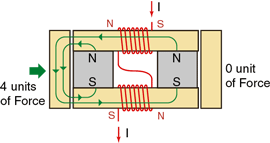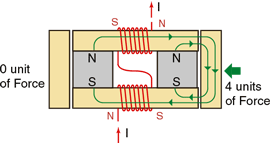|
Page 2 |
Flynn Research Defining The Shape Of Science & Technology |
|
Parallel Path Magnetic Technology, Geometry: |
|
|
|
|
| The magnetic circuit is again modified by placing a coil on each flux path as shown at the right. If no current flows in the the coils then the magnetic circuit remains the same as if the coils do not exist. |
|
|
|
|
| However if current flows in the coils to produce a magnetic
polarity as shown at the right the resulting events occur. The
magnetic flux produced by the coils couple with the permanent
magnet flux and the result is as shown. The magnet on the right
and the coils are magnetically in series. Since they are in
series there is no gain in flux density.
The magnet on the right and the coil's flux are now placed in parallel with the flux of the magnet on the left, with a resulting equivalent of the flux of both magnets passing through the armature on the left. The result is no force acting on the armature on the right and 4 units of force acting on the armature on the left. The coil only contributes 1/2 of the magnetic field that is producing the force on the left armature. At this point the advantage of Parallel Path Magnetic Technology should be obvious. The reason the flux cannot pass through the armature on the right is partly due to the axiom that a magnetic source's poles will couple with the nearest opposite pole. However at the same time it is impossible for both the coil's flux and the magnet's flux to both pass through the armature on the right. Their fluxes would be traversing the armature in opposite directions. Flux can pass through the armature on the right, however, if an excess of flux is produced by the coil. Excess flux is covered on page 4. |
|
|
|
|
| The magnetic circuit at the right is identical to the
preceding circuit with the exception of the polarity of the
coils. The current through the coils is reversed and and thus
the polarity is reversed.
The sum of the fluxes now traverses the armature on the right resulting in 4 units of force acting on the armature on the right and no force on the armature on the left. The ability to arbitrarily move the force from one point to another is the basis for motion or work. |
|
|
|
|
| Next we will compare conventional electro-magnetic circuits with Parallel Path Magnetic Technology, cover input power and verify Parallel Path Magnetic Technology with both finite element analysis and physical measurement. | |
|
|
|
Parallel Path Magnetic Technology is a Trademark of Flynn Research Inc. Copyright 1999 Flynn Research
Patents Pending
|
|
| Flynn Research Inc. |
| Contents Page 1 Page 2 Page 3 Page 4 Page 5 Page 6 Page 7 Test Setup Test Results |
|
For Website Information Contact: webmaster@flynnresearch.net |




